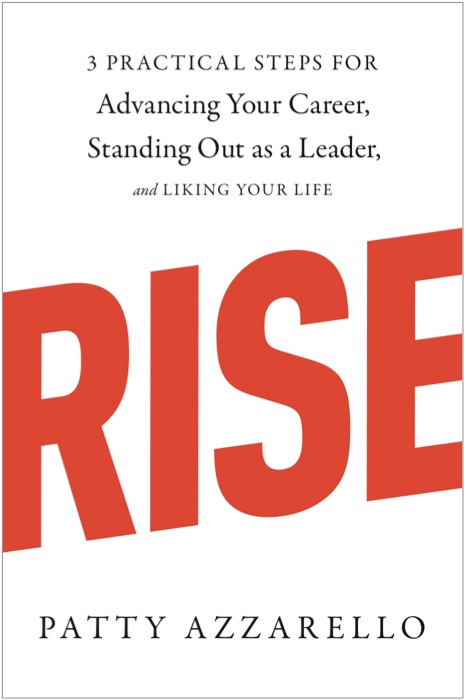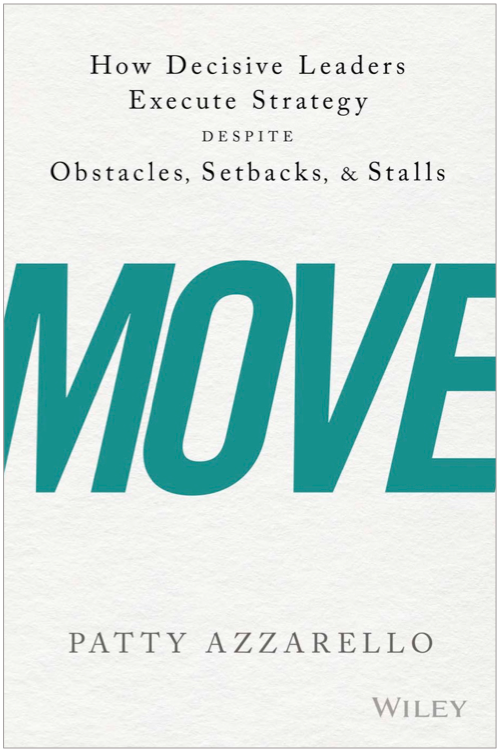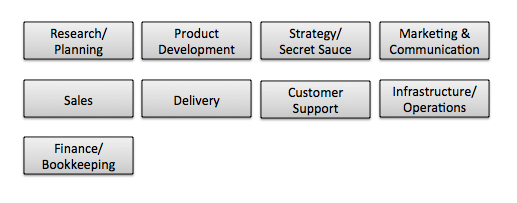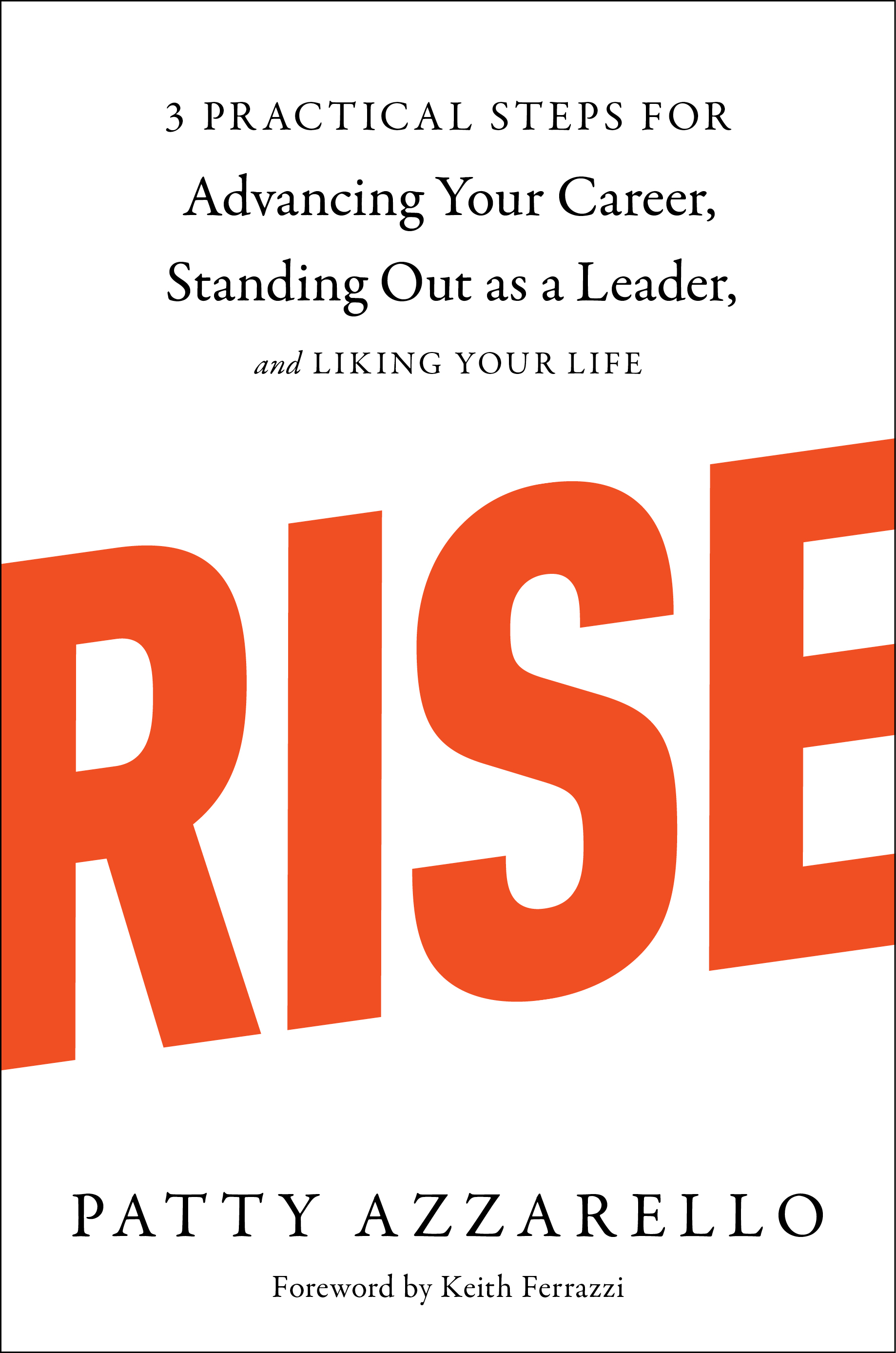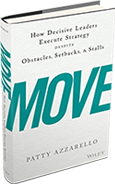What is an org chart for?
This was a lesson I learned in my corporate career, and have carried through to my entrepreneurial career.
When you think of an org chart, people usually think about it as a way to visually organize people.
To me this misses the value of the org chart entirely.
What an org chart should convey are groupings of actions, work and desired outcomes. — The fact that there are people in the boxes is secondary.
Any business has a task-outcome oriented org chart that is a tuned version of this.
When I started my business, even though I was only one person at the time, my business still had all of these required activities and outcomes.
So I drew an org chart that looked very much like the one above. Under each one of these I listed the outcomes that my business had to deliver in the next year.
It just so happned that my name was in all of the boxes!
Remember an org chart is not about the people. It’s about what needs to get done.
(see also: The ideal, blank-sheet org chart)
Planning time and resources
Then when I planned my time, I could make sure that I was spending some time in all of the necessary roles ranging across: creative genius, sales person, and IT guy. It gave me a clear view of what work I could do myself and where I needed to find help.
A Small Business MUST
This is a must exercise for a small business or partnership.
One of the biggest problems small businesses face is vague expectations and understanding about who is doing what at any point in time, and which things are left uncovered. Drawing it out and agreeing on who is on the hook for each work area and which outcomes, solves the problem.
The corporate manager version
But let’s get back to corporate.
Every corporate management job has multiple roles and necessary outcomes associated with the job.
So it’s important to draw a 1-person org-chart for your job, that shows all the stuff you’re on the hook for.
Here’s an example:
Prioritize Better
The value of doing this is that you can begin to prioritize and budget your time across these categories on purpose. You can make sure that you are not getting too stuck on one area and missing another critical area entirely.
Negotiate Better
The other benefit of having this is that it is a great way to negotiate your work with your manager and your team and your peers. You can be really clear about what outcomes you are personally driving and why.
It also makes a great visual tool for either offense or defense, when dealing with an unreasonable workload.
An example: You are not getting a TBH approved
If you have TBH, which is not approved, and you as the manager, are the one currently doing the work, the most dangerous thing you can do is to just do the work.
If you are covering the work personally, and working evenings and weekends to do so, it’s important to realize that you are only proving that you don’t really need that hire – the work is getting done. No one cares that you are killing yourself. Your company can absorb an unlimited amount of work from you.
Don’t get stuck
The other thing that is dangerous about this (other than dying from it) is that others begin to see you in that job. The lower level job. Forever after. They expect you to keep doing that job.
The trick here is to make sure that your team overall is delivering results, but not to get stuck personally with that workload permanently.
And to do that, while you might need to temporarly cover for work that you should be delegating because there is no one to do it, you can’t let it stick to you.
This “draw your org chart” approach can come to the rescue.
You draw the org chart for your role at the top level, showing all the important managerial work you need to be doing. And then you create another one for all the work that the missing person needs to do.
Show your job (1) and the extra work (2) as 2 separate jobs
Once you draw your org chart for your job and your draw a differnt org chart for the extra work, you clearly define them as two different jobs.
Then you can start saying things like, “In addition to all the things I am doing in my real job, I have been trying my best to cover the most important 25% of the things in the missing person’s job. But it’s not all getting done, and it is not sustainable for me to keep doing this. We need to hire the person for this second job.”
Saying NO, and gaining credibility
By creating an org chart based on tasks and outcomes, you give yourself a lot of power to work in a way that is more reasonable. I always say that it is much more impressive to talk about what you ARE doing, not what you are NOT doing.
Just saying, “No, I can’t do that” is not very impressive! But if you can pull out your org-chart description of your job, you can say, “look at all the stuff I AM doing”, and people can better appreciate the importance of your contribution.
Create positive visibility
Communicating in this way is also a very good way to make your work visible without being annoying.
By sharing the complete context of your role when you talk with others, they will be able to see all the things you are doing behind the scenes which are building capacity and reducing risk, and adding value — which might not be otherwise obvious from their infrequent interactions with you.
What’s the different between this approach and a job description?
In my experience, job descriptions tend to list theoretical responsibilites. They tend to be long and have a lot of text.
The 1-person org chart has the benefit of being simple and graphical. It’s more concrete. It’s easier to understand quickly, and therefore it is a much better communication tool.
And if it is task-outcome oriented, it becomes a good sales tool for getting resources to get the things done that are in the boxes.
What do you think?
Join the conversation about this on my facebook page.
Was this useful?
If you found this article useful, please help me share it with others and encourage them to subscribe to this Blog for free.
Patty Azzarello is an executive, best-selling author, speaker and CEO/Business Advisor. She became the youngest general manager at HP at the age of 33, ran a billion dollar software business at 35 and became a CEO for the first time at 38 (all without turning into a self-centered, miserable jerk)
You can find Patty at www.AzzarelloGroup.com, follow her on twitter or facebook.
And make sure to read her book
RISE…3 Practical Steps for Advancing Your Career, Standing Out as a Leader, AND Liking Your Life.
The answers to your career struggles and your next promotion are in it!
